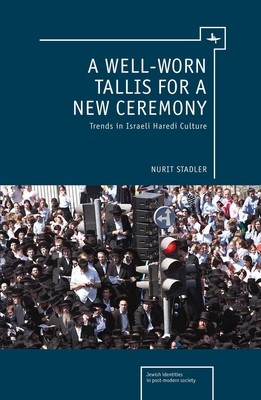
- We will send in 10–14 business days.
- Author: Nurit Stadler
- Publisher: Academic Studies Press
- ISBN-10: 193623582X
- ISBN-13: 9781936235827
- Format: 15.6 x 23.4 x 1.1 cm, kieti viršeliai
- Language: English
- SAVE -10% with code: EXTRA
Reviews
Description
A Well-Worn Tallis for a New Ceremony is a study of contemporary ultra-Orthodox religiosity in Israel. This book analyzes the ongoing reconstruction of Haredi culture in Israel, a process which has been spurred on by the challenges of modernity, the worldwide resurgence of religion, and the strong sway of Israeliness. Despite its founders' and the present leadership's long-standing eff orts to establish and buttress a community enclave, various modern trends and state institutions, such as secularization, consumerism, feminism, and the military, are having a profound impact on the yeshiva world. In other words, modernity is making inroads into the Jewish state's Haredi "ghetto" and transforming many aspects of everyday life. Over the course of her extended research on this community, Stadler has discerned changes in several key areas, including religious life; the family structure; and the community's interface with government authorities and the rest of the populace. Her book sheds light on all of these developments.
EXTRA 10 % discount with code: EXTRA
The promotion ends in 23d.12:25:43
The discount code is valid when purchasing from 10 €. Discounts do not stack.
- Author: Nurit Stadler
- Publisher: Academic Studies Press
- ISBN-10: 193623582X
- ISBN-13: 9781936235827
- Format: 15.6 x 23.4 x 1.1 cm, kieti viršeliai
- Language: English English
A Well-Worn Tallis for a New Ceremony is a study of contemporary ultra-Orthodox religiosity in Israel. This book analyzes the ongoing reconstruction of Haredi culture in Israel, a process which has been spurred on by the challenges of modernity, the worldwide resurgence of religion, and the strong sway of Israeliness. Despite its founders' and the present leadership's long-standing eff orts to establish and buttress a community enclave, various modern trends and state institutions, such as secularization, consumerism, feminism, and the military, are having a profound impact on the yeshiva world. In other words, modernity is making inroads into the Jewish state's Haredi "ghetto" and transforming many aspects of everyday life. Over the course of her extended research on this community, Stadler has discerned changes in several key areas, including religious life; the family structure; and the community's interface with government authorities and the rest of the populace. Her book sheds light on all of these developments.


Reviews